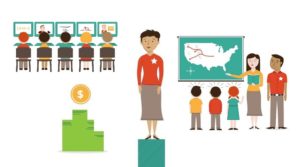
Teachers using blended learning need guidance to help students achieve high-growth learning consistently. Teacher-leaders and their teams need time to collaborate and learn together on the job. Students need access to personalized instruction that catalyzes consistently high growth and expands their thinking.
How can schools achieve all of these goals? Combine blended learning with teacher leadership. Two new models from Public Impact® explain how elementary and secondary schools can combine Time-Technology Swaps and Multi-Classroom Leadership— while paying teachers far more, sustainably.

In middle and high schools, students in these models rotate on a fixed schedule between a learning lab and regular classrooms—a “Time-Technology Swap.” In the lab, students learn online, using digital instruction, and offline, pursuing skills practice and project work. This lab time, supervised by paraprofessionals, frees teachers’ time. That time allows teachers, working on teams led by multi-classroom leaders, to teach additional classes, and to plan and collaborate with their teammates on the job. Class time with the teacher is focused primarily on engaging portions of instruction that are best taught in person and in small-group follow-up. Lab work is chosen and directed by the multi-classroom leaders and their team teachers, and is personalized to each student. In some high schools, students do assigned digital learning and project work at home during part of the school day, rather than in a learning lab.
In elementary schools, students similarly engage in personalized digital learning and/or offline skills practice and project work for a limited, age-appropriate portion of the day at school. This frees multi-classroom leaders and team teachers to reach more students without increasing instructional group sizes, and to plan and improve together based on data about student progress each week.
Why should schools combine blended learning and teacher-led teams?
- All students reached with excellence: 100 percent of students can have one or more excellent teachers responsible for their learning in each affected subject, without larger classes.
- On-the-job learning and support for teachers: Teachers can gain and consolidate planning and collaboration time, and teachers can get more support and on-the-job development from multi-classroom leaders.
- Teachers earn more—often much more: Pay increases of up to 67 percent are possible for multi-classroom leaders, while pay for blended-learning teachers on the team can increase up to about 25 percent, within regular budgets, not temporary grants.
Many Opportunity Culture® schools are already combining Time Swaps and Multi-Classroom Leadership. These new models offer a glimpse at what they are doing, and provide a starting point for additional schools that want to reach all students with excellent teaching and provide all teachers with career advancement opportunities and on-the-job development and support—creating an Opportunity Culture® for all.
Note: Public Impact® and Opportunity Culture® are registered trademarks; Multi-Classroom Leader® and Multi-Classroom Leadership™ are trademarked terms, registration pending.
